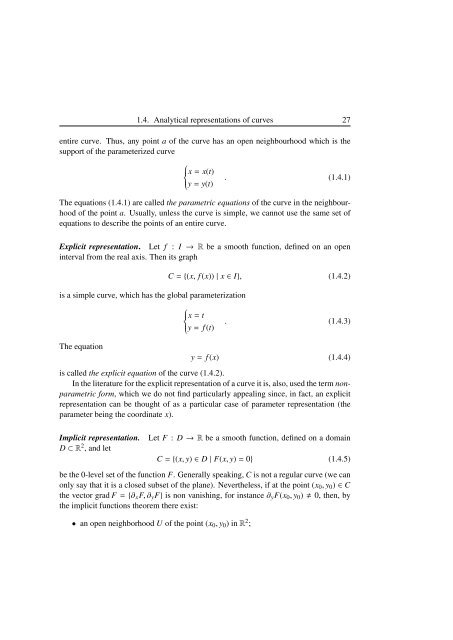Blaga P. Lectures on the differential geometry of - tiera.ru
Blaga P. Lectures on the differential geometry of - tiera.ru
Blaga P. Lectures on the differential geometry of - tiera.ru
Create successful ePaper yourself
Turn your PDF publications into a flip-book with our unique Google optimized e-Paper software.
1.4. Analytical representati<strong>on</strong>s <strong>of</strong> curves 27<br />
entire curve. Thus, any point a <strong>of</strong> <strong>the</strong> curve has an open neighbourhood which is <strong>the</strong><br />
support <strong>of</strong> <strong>the</strong> parameterized curve<br />
⎧<br />
⎪⎨ x = x(t)<br />
⎪⎩ y = y(t)<br />
. (1.4.1)<br />
The equati<strong>on</strong>s (1.4.1) are called <strong>the</strong> parametric equati<strong>on</strong>s <strong>of</strong> <strong>the</strong> curve in <strong>the</strong> neighbourhood<br />
<strong>of</strong> <strong>the</strong> point a. Usually, unless <strong>the</strong> curve is simple, we cannot use <strong>the</strong> same set <strong>of</strong><br />
equati<strong>on</strong>s to describe <strong>the</strong> points <strong>of</strong> an entire curve.<br />
Explicit representati<strong>on</strong>. Let f : I → R be a smooth functi<strong>on</strong>, defined <strong>on</strong> an open<br />
interval from <strong>the</strong> real axis. Then its graph<br />
is a simple curve, which has <strong>the</strong> global parameterizati<strong>on</strong><br />
The equati<strong>on</strong><br />
C = {(x, f (x)) | x ∈ I}, (1.4.2)<br />
⎧<br />
⎪⎨ x = t<br />
⎪⎩ y = f (t)<br />
. (1.4.3)<br />
y = f (x) (1.4.4)<br />
is called <strong>the</strong> explicit equati<strong>on</strong> <strong>of</strong> <strong>the</strong> curve (1.4.2).<br />
In <strong>the</strong> literature for <strong>the</strong> explicit representati<strong>on</strong> <strong>of</strong> a curve it is, also, used <strong>the</strong> term n<strong>on</strong>parametric<br />
form, which we do not find particularly appealing since, in fact, an explicit<br />
representati<strong>on</strong> can be thought <strong>of</strong> as a particular case <strong>of</strong> parameter representati<strong>on</strong> (<strong>the</strong><br />
parameter being <strong>the</strong> coordinate x).<br />
Implicit representati<strong>on</strong>. Let F : D → R be a smooth functi<strong>on</strong>, defined <strong>on</strong> a domain<br />
D ⊂ R 2 , and let<br />
C = {(x, y) ∈ D | F(x, y) = 0} (1.4.5)<br />
be <strong>the</strong> 0-level set <strong>of</strong> <strong>the</strong> functi<strong>on</strong> F. Generally speaking, C is not a regular curve (we can<br />
<strong>on</strong>ly say that it is a closed subset <strong>of</strong> <strong>the</strong> plane). Never<strong>the</strong>less, if at <strong>the</strong> point (x0, y0) ∈ C<br />
<strong>the</strong> vector grad F = {∂xF, ∂yF} is n<strong>on</strong> vanishing, for instance ∂yF(x0, y0) � 0, <strong>the</strong>n, by<br />
<strong>the</strong> implicit functi<strong>on</strong>s <strong>the</strong>orem <strong>the</strong>re exist:<br />
• an open neighborhood U <strong>of</strong> <strong>the</strong> point (x0, y0) in R 2 ;












